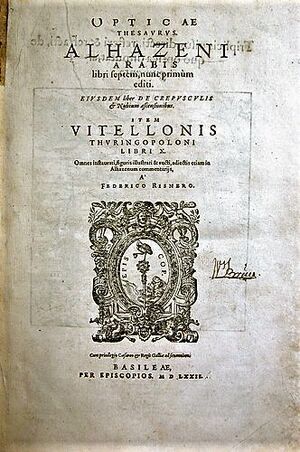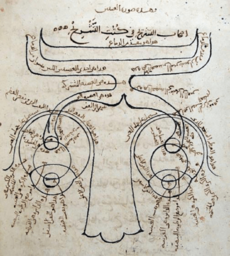Book of Optics facts for kids
Quick facts for kids 
Cover page for Ibn al-Haytham's Book of Optics in the print edition from 1572
|
|
| Author | Ibn al-Haytham |
|---|---|
| Original title | كتاب المناظر |
| Language | Arabic |
| Published | 1011 to 1021 |

The Book of Optics (in Arabic: Kitāb al-Manāẓir) is a super important book about optics. It was written by a smart scholar named Ibn al-Haytham. People in the West knew him as Alhazen. He lived from 965 to about 1040 AD.
This book has seven parts. It changed how people thought about how we see things. It used experiments to show that light enters our eyes. This idea is called the intromission theory. Before this book, many people believed that our eyes sent out rays to see objects. This was called the extramission theory.
The Book of Optics also showed an early use of the scientific method. It described the camera obscura, which is like a pinhole camera. It also explained a famous math problem known as Alhazen's problem. This book had a huge impact on physics, mathematics, and optics in Europe for hundreds of years.
Contents
How We See: Vision Theories
Before the Book of Optics, there were two main ideas about how we see.
Eyes Sending Out Rays
One idea was the extramission theory. Famous mathematicians like Euclid and Ptolemy believed this. They thought our eyes shot out invisible rays. When these rays hit an object, we could see its color, shape, and size.
Light Entering Our Eyes
The other idea was the intromission theory. Followers of Aristotle and Galen thought that something came from the object or its surroundings. This "something" then entered our eyes, allowing us to see.
Ibn al-Haytham found many reasons why the extramission theory didn't make sense. For example, he noted that looking directly at bright lights, like the sun, can hurt our eyes. If our eyes sent out rays, why would bright light hurt them? He also wondered how our eyes could instantly fill all of space with rays when we look at the night sky.
He supported the intromission theory. He explained that every point on an object sends out light rays in all directions. Some of these rays then travel into our eyes. He saw an object as having countless tiny points. Each point sends out light rays.
Understanding Light and Color
In the Book of Optics, Ibn al-Haytham talked about two kinds of light.
Primary and Secondary Light
He said there's primary light, which is very strong. This light comes from things that glow on their own, like the sun or a lamp. Then there's secondary light. This comes from objects that don't glow on their own. Instead, they get light from primary sources and then reflect it. Secondary light can only exist if there's a primary light source.
Both primary and secondary light always travel in straight lines.
Transparency and Opacity
The book also explains how light moves through different materials.
- Transparency means a material lets light pass through it. Think of air or water. But no material is perfectly clear; some light is always blocked.
- Opaque objects are ones that light cannot pass through directly. However, some opaque objects can still let a little light through. When light hits an opaque object, the object can then reflect that light. This reflected light is secondary light.
Ibn al-Haytham also showed that light can bend when it passes through clear objects. This is called refraction. Light can also bounce off smooth surfaces, like mirrors. This is called reflection. In both cases, light still travels in straight lines.
Color and Light
He did many experiments to prove his ideas about light. He also believed that color acts much like light. He thought color is a special quality of an object. It travels from every point on an object in straight lines, just like light. He even found that color needs air to exist.
The Eye and How We See Images

Since objects send out light rays in all directions, our eyes are hit by many rays. This caused a puzzle: if all rays hit the eye, why don't we see a blurry mess?
Ibn al-Haytham solved this using his idea of refraction. He said that an object sends countless rays to the eye. But only one ray from each point on the object hits the eye straight on (perpendicularly). All the other rays hit at an angle. When they hit at an angle, they are bent and become weaker. He believed that only the rays that hit the eye straight on are used for clear vision.
Parts of the Eye
In his view of the eye, the crystalline humor (which is like the lens) is key. It receives the light rays and forms a visual cone. The object we see is the wide base of this cone. The center of the crystalline humor is the point of the cone.
Other parts of the eye include the aqueous humor (in front) and the vitreous humor (at the back). But these parts were not as important for vision as the crystalline humor. The crystalline humor then sends the image it sees to the brain through the optic nerve.
What's in Each Book?
The Book of Optics is divided into seven volumes, each focusing on different ideas:
- Book I talks about Ibn al-Haytham's ideas on light, colors, and how we see.
- Book II explains his theory of how we perceive what we see.
- Book III and Book VI discuss mistakes or errors in how we see things. Book VI specifically looks at errors caused by reflection.
- Book IV and Book V provide proof from experiments for his ideas about reflection.
- Book VII focuses on the concept of refraction, which is when light bends.
How the Book Changed Science
The Book of Optics was greatly influenced by Ptolemy's own book on optics. Also, Ibn al-Haytham's descriptions of the eye were based on the work of Galen.
This book was translated into Latin around the late 1100s or early 1200s. It became very important during the Middle Ages in Europe. In 1572, a scholar named Friedrich Risner published it as part of a collection called Opticae thesaurus. This collection also included other important works on optics.
See also
- History of optics
- Ibn Sahl
- Scientific method

